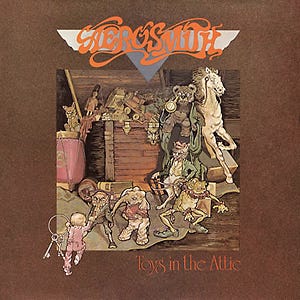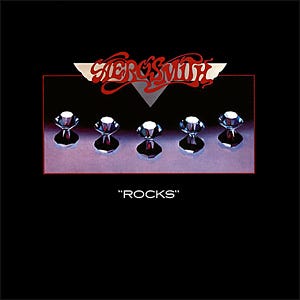How to talk to your child about both mortality and Aerosmith
To the extent there is a difference, conceptually
This post is part of an ongoing series in which I manfully explain music from my record collection to our child, who is a one-year-old baby. Previous installments can be found here:
You might have noticed that the majority of your dad’s records are by bands playing rock and roll, which was the default form of popular music during the last half of the 20th Century. People refer to this time as “the nineteen-hundreds” when they want to antagonize somebody of your dad’s generation by reminding them how old and obsolete they are, and how little their tastes and ideas matter to those who are young currently.
Indeed, it is impossible to browse a large LP collection such as your father’s (and, by extension, yours) and not feel the weight of time. “Time” is the chronological measurement of our actions across the finite plane of existence that enables us to describe cause and effect. It is a complicated subject in both physics and philosophy, as there tends to be fundamental disagreement about whether time exists objectively in the universe or if it is merely a function of our perception. For what it’s worth, I encourage you never to converse with an A.I. chatbot about the concept of time, lest you have the same haunting experience I did a few minutes ago.
Time allows us to separate events into past, present and future tenses. Rock music increasingly exists in what we think of as the past tense. This has not always been the case. When rock and roll first emerged into American popular culture in the 1950s (give or take), it was associated with youth, vitality and rebellion against the status quo. Now, about 70 years later, rock signifies exactly the opposite of those things. It began as a frivolous fad that was sold to teenagers, then became a catalyst for social change, then turned into serious art, then got assimilated into the mainstream, then got overexposed and diluted, then got boring and heavily monetized, then faded from cultural centrality.
Today, rock is primarily performed and consumed by a gerontocracy that has money and enforces the social conventions that the music once challenged. This is what always happens when white people seize control of a cultural movement they did not invent. There was a good explanation of this process in an episode of a podcast called A History of Rock Music in 500 Songs:
“The story of rock and roll is the story of men crowding out women, and white men crowding out black men, and finally of rich white men crowding out poorer white men until it eventually becomes a dull, conservative genre.”
So as a half-white American girl, you are, let’s say, only 25 percent personally responsible for the decline of rock music. (A “podcast” is a medium of audio content disproportionately consumed by men who are douchebags.)
As it fades away, many of rock’s key figures are leaving us. Just last month, the artists Brian Wilson and Sly Stone, who were both influential for different reasons, died within a few days of each other at age 82. There was a period in 2016 when both David Bowie and Prince, also important contributors to the history of rock, died within a span of a few months, resulting in a wide expression of communal grief. One day we’ll wake to the news that Bob Dylan (84) is gone. Or Paul McCartney (82), or Neil Young (79). We could lose Mick Jagger and Joni Mitchell (both 81) in the same week. Or Stevie Wonder and Bruce Springsteen (both 75). Lots of people will be sad; none will be shocked.
Some light food for thought
To “die” means to no longer be alive. When a person dies, their heart stops pumping blood through their body, and their brains and internal organs cease to function. People have a lot of passionate opinions about what happens to our consciousness after death, but nobody really knows, and the more they want to talk to you about it, the less secure they are in their beliefs. Consciousness is a person’s subjective awareness of…actually, let’s just stay on topic.
Increasingly, the function of rock music is to offer a proxy for mortality, which is the awareness that death is coming. This thought occurred to your dad because, as Mr. Wilson and Mr. Stone died, he was reading a book called The Twilight of the Gods: A Journey to the End of Classic Rock, by the music critic Steven Hyden. The book, published in 2018, eulogizes an art form that is still young enough to shape the popular music of today, but old enough to have started vanishing before our eyes. In it, Mr. Hyden writes: “Like all precious minerals, classic rock is a finite resource. You can’t talk about classic rock now without thinking about death.”
This is true, although the book never precisely defines “classic rock,” because like all music genre categories, it is a nebulous concept whose label has less to do with how the music sounds than how it is marketed. But for the sake of discussion, let’s describe classic rock as anything that could get played alongside “Sweet Emotion” on a terrestrial FM radio station whose mascot is an imposing animal, such as a bear or a wolf.
A radio is a device that receives and amplifies audio broadcasts across publicly regulated airwaves. It is like streaming, except you have no control over what gets played and you have to listen to a commercial for a mattress store every twelve minutes, which is pretty annoying, but on the other hand the radio does not harvest and sell your personal data. If you live in a midsized radio market in the American Midwest, which we do, federal regulations mandate that at least one station be playing “Sweet Emotion” at all times. I’ll give you a minute to verify this, if you can find a working radio.



Aerosmith: Get Your Wings (1974); Toys in the Attic (1975); Rocks (1976)
“Sweet Emotion” is by a band called Aerosmith, and it is one of the greatest dumb rock songs ever made. It has a stoner-friendly bass groove and features guitars with a talk-box effect, which is even more cumbersome to use than it is to listen to. The lyrics are about nothing in particular, but the line referencing “a sweat-hog mama with a face like a gent” seems to have foreshadowed the band’s taste for novelty songs that are vaguely transphobic.
It’s hard to explain, but “Sweet Emotion” sounds like the taste of your first cigarette: obviously not nourishing or even healthy, but also curiously irresistible. It sounds like the feeling of ashing that cigarette out the passenger-side window of a speeding van that has a flaming skull painted on the side of it. Incidentally, cigarettes are becoming “cool” again because young people are idiots. I’d rather you didn’t smoke at all, but if you do, just remember that it starts to look disgusting the moment you turn 26, and that you’ll risk projecting what kids today might call “stepmom energy.”
“Sweet Emotion” appeared on Aerosmith’s third album, Toys in the Attic, which came out in 1975. This was in the middle of Aerosmith’s original heyday. A “heyday” is a period in the life of a person or group when they have the world by the balls but don’t know it until those same balls start to elude their grasp. Balls are human testicles; “by the balls” is just a figure of speech.
Usually a heyday occurs in someone’s 20s, when they peak in both conventional physical attractiveness and many kinds of performance capacity, but almost always lack the perspective to maximize the fleeting opportunities that are available to them in this tragically brief window. It tends to be the period when musicians do their best work, because music is an artistic medium that rewards immediacy and raw emotion more so than perspective. In some ways, this is heartbreaking, because it means artists almost never recognize that they have reached their apex until after the fact.
It is also when people consume the most drugs, because their bodies can usually withstand the effects, and the concept of “mortality” has not started to factor into adult decision-making. This was very much the case with the members of Aerosmith. Here is a video of them performing “Sweet Emotion” during this period of their lives, unaware that everything was about to fall apart due to their over-indulgence in recreational substances:
For a deeper explanation of how drugs both enhance and inhibit musical creativity, particularly when ingested nasally, refer to our earlier conversation about Fleetwood Mac. Aerosmith is unique in that its drug-induced depravity eclipsed that of Fleetwood Mac, which is not a minor achievement.
What a bunch of dirtbags
Case in point, Steven Tyler, the band’s singer, features in some sex lore that is fucked-up even by rock-star standards. Long story short, he convinced the mother of a female “groupie” to grant him legal custody of the girl, who was 16, so Mr. Tyler, then 25, could take her on tour and have sex with her in multiple states without getting arrested, which is probably what should have happened to him. This is because age-of-consent laws differ from state to state, and if any man ever mentions this concept to you, kick him in the nuts and run away. “Nuts” is another term for human testicles.
Before going off the rails in the late ‘70s, Aerosmith had recorded a handful of bluesy rock albums that were received, correctly, as cartoonish American facsimiles of earlier and better music by the Rolling Stones and Led Zeppelin, bands from the U.K. who were themselves ripping off the work of Black American R&B artists. The relationship between cultural influence and race is a really big can of worms. “Can of worms” is an expression parents use when they realize they have introduced a topic they are in no way qualified to unpack.
Unlike most bands, Aerosmith got to experience a second heyday when they were old and sober enough to take advantage of it. After they stopped doing drugs, they hired professional songwriters to retool their sound and image for rock radio and became hugely successful on MTV, assembling a later catalog that overshadowed their early work despite containing music that is mostly very silly.
This period resulted in several more great dumb rock songs (“Rag Doll,” “Livin’ on the Edge”); multiple prom ballads (“Angel,” “Crazy,” “Cryin’”); a song about women’s genitalia that the members of Aerosmith were probably too old to release when they did without sounding creepy (“Pink”); a song for the soundtrack of a world-historically ridiculous action movie (“I Don’t Want to Miss a Thing”); and a song whose political message is both righteous and wildly tone-deaf (“Janie’s Got a Gun”). During this comeback period, Aerosmith took a lot of criticism for “selling out,” which is an indecipherable concept to anybody born after 1990.
And other outdated ideas, such as “retirement”
If you ever see Aerosmith in concert, you’ll probably notice that both halves of their catalog coexist seamlessly. Your dad went to his first and presumably only Aerosmith show about ten years ago on what was then advertised as their farewell tour. (They have since toured several more times.) They sounded pretty good but looked like absolute shit. Both Mr. Tyler and Mr. Perry seemed as though they were held together by electrical tape and could unravel at any minute.
But while it’s easy to make fun of past-their-prime rock stars, the evolution of classic rock invites and perhaps requires us to think more expansively about the subject of aging. The band members were mostly in their late 60s at the time, which means they’re in their late 70s now, and are still threatening to tour more. So what are people who are that old, especially ones who have consumed staggering amounts of dangerous chemicals, supposed to look and sound like?
People only comment on their appearance relative to their age because they are getting old visibly in a public setting, a mixed blessing that most of us will never experience. Generally, people get old and die without anybody wanting to pay them to play songs from 50 years ago — in Mr. Tyler’s case, while twirling around a microphone stand excessively adorned in scarves, dressed like a witchy aunt. Most of us won’t be expected to do much of anything, really, other than to express opinions that seem normal to us but have become offensive to everybody else, and to look at our phones every few minutes and wonder if our kids are just very busy this week. (No pressure here, sweetheart.)
People change a lot as time passes, but recorded songs mostly do not. This gives music a unique, frozen-in-amber quality, in that songs are things people change not with but in relation to. So however enfeebled Aerosmith looks performing “Sweet Emotion” in recent years — we’re also that much further away from the heyday of our own youths in which we first encountered it. Aerosmith has gotten old, and therefore so have we.
But “Sweet Emotion” — which was their final song at the show your dad saw — sounds the same as it ever did, and as it always will, even after the scarves have fallen off our microphone stands, and we all get driven toward the sunset, below the speed limit, in a van that still has a skull painted on the side of it, even though the image has faded, and the turn signal has been blinking for who knows how long. This is a metaphor for dying. Metaphors are rhetorical devices people use when they want to sidestep a devastating reality.


